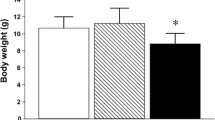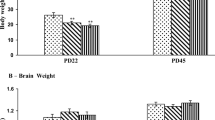Abstract
The main purpose of this study was to verify the hypothesis that cognitive dysfunctions induced by arsenic exposure were related to the changes of d-serine metabolism in the hippocampus of offspring mice. Mother mice and their offsprings were exposed to 0, 15, 30 or 60 mg/L sodium arsenite (NaAsO2) through drinking water from the first day of gestation until the end of lactation. d-serine levels in the hippocampus of mice of postnatal day (PND) 10, 20 and 40 were examined by high-performance liquid chromatography. Expressions of serine racemase (SR), d-amino acid oxidase (DAAO), alanine–serine–cysteine transporter-1 (asc-1) and subunits of N-methyl-d-aspartate receptors (NMDARs) in the hippocampus of mice were measured by Western blot and Real-time RT-PCR. Results showed that arsenic exposure significantly decreased d-serine levels of mice exposed to 60 mg/L NaAsO2. Exposure to 60 mg/L NaAsO2 could inhibit both mRNA and protein expression of SR, whereas increase in the protein expression of DAAO, only enhances the mRNA levels of DAAO of PND 20 mice. In addition, arsenic exposure could upregulate protein expression of asc-1. The mRNA and protein levels of NR1, NR2A and NR2B in the hippocampus of mice were down-regulated by arsenic. Findings from this study suggested that SR might play an important role in the reduction of d-serine levels caused by arsenic exposure, which might further influence the levels of NMDAR subunits especially on PND20, and then might disturb the function of NMDARs and cause the deficits of learning and memory ability of offspring mice.










Similar content being viewed by others
References
Argos M, Kalra T, Pierce BL, Chen Y, Parvez F, Islam T, Ahmed A, Hasan R, Hasan K, Sarwar G, Levy D, Slavkovich V, Graziano JH, Rathouz PJ, Ahsan H (2011) A prospective study of arsenic exposure from drinking water and incidence of skin lesions in Bangladesh. Am J Epidemiol 174(2):185–194
Basu AC, Tsai GE, Ma CL, Ehmsen JT, Mustafa AK, Han L, Jiang ZI, Benneyworth MA, Froimowitz MP, Lange N, Snyder SH, Bergeron R, Coyle JT (2009) Targeted disruption of serine racemase affects glutamatergic neurotransmission and behavior. Mol Psychiatry 14(7):719–727
Billard JM (2012) d-Amino acids in brain neurotransmission and synaptic plasticity. Amino Acids 43:1851–1860
Bliss TVP, Collingridge GL (1993) A synaptic model of memory: long-term potentiation in the hippocampus. Nature 361(6407):31–39
Cercato MC, Colettis N, Snitcofsky M, Aguirre AI, Kornisiuk EE, Baez MV, Jerusalinsky DA (2014) Hippocampal NMDA receptors and the previous experience effect on memory. J Physiol Paris 108(4–6):263–269
Choi SR, Roh DH, Yoon SY, Choi HS, Kang SY, Han HJ, Beitz AJ, Lee JH (2019) Astrocyte d-serine modulates the activation of neuronal NOS leading to the development of mechanical allodynia in peripheral neuropathy. Mol Pain 15:1744806919843046
Coyle JT, Balu DT (2018) The role of serine racemase in the pathophysiology of brain disorders. Adv Pharmacol 82:35–56
Guercio GD, Panizzutti R (2018) Potential and challenges for the clinical use of d-Serine as a cognitive enhancer. Front Psychiatry 9:14
Helboe L, Egebjerg J, Møller M, Thomsen C (2003) Distribution and pharmacology of alanine-serine-cysteine transporter 1 (asc-1) in rodent brain. Eur J Neurosci 18(8):2227–2238
Henneberger C, Papouin T, Oliet SH, Rusakov DA (2010) Long-term potentiation depends on release of d-serine from astrocytes. Nature 463(7278):232–236
Hopkins SC, Campbell UC, Heffernan ML, Spear KL, Jeggo RD, Spanswick DC, Varney MA, Large TH (2013) Effects of d-amino acid oxidase inhibition on memory performance and long-term potentiation in vivo. Pharmacol Res Perspect 1(1):e00007
Inoue R, Hashimoto K, Harai T, Mori H (2008) NMDA- and betaamyloid1-42—induced neurotoxicity is attenuated in serine racemase knock-out mice. J Neurosci 28(53):14486–14491
Inoue R, Talukdar G, Takao K, Miyakawa T, Mori H (2018) Dissociated role of d-serine in extinction during consolidation vs. reconsolidation of context conditioned fear. Front Mol Neurosci 11:161
Ishiwata S, Umino A, Balu DT, Coyle JT, Nishikawa T (2015) Neuronal serine racemase regulates extracelluar d-serine levels in the adult mouse hippocampus. J Neural Transm (Vienna) 122(8):1099–1103
Lin H, Jacobi AA, Anderson SA, Lynch DR (2016) d-Serine and serine racemase are associated with PSD-95 and glutamatergic synapse stability. Front Cell Neurosci 10:34
Liraz-Zaltsman S, Slusher B, Atrakchi-Baranes D, Rosenblatt K, Friedman Levi Y, Kesner E, Silva AJ, Biegon A, Shohami E (2018) Enhancement of brain d-serine mediates recovery of cognitive function after traumatic braininjury. J Neurotrauma 35(14):1667–1680
Luo JH, Qiu ZQ, Shu WQ, Zhang YY, Zhang L, Chen JA (2009) Effects of arsenic exposure from drinking water on spatial memory, ultra-structures and NMDAR gene expression of hippocampus in rats. Toxicol Lett 184(2):121–125
Luo JH, Qiu ZQ, Zhang L, Shu WQ (2012) Arsenite exposure altered the expression of NMDA receptor and postsynaptic signaling proteins in rat hippocampus. Toxicol Lett 211(1):39–44
Maucler C, Pernot P, Vasylieva N, Pollegioni L, Marinesco S (2013) In vivo d-serine hetero-exchange through alanine–serine–cysteine (ASC) transporters detected by microelectrode biosensors. ACS Chem Neurosci 4(5):772–781
Naujokas MF, Anderson B, Ahsan H, Aposhian HV, Graziano JH, Thompson C, Suk WA (2013) The broad scope of health effects from chronic arsenic exposure: update on a worldwide public health problem. Environ Health Perspect 121(3):295–302
Newman JD, Navas-Acien A, Kuo CC, Guallar E, Howard BV, Fabsitz RR, Devereux RB, Umans JG, Francesconi KA, Goessler W, Best LT, Tellez-Plaza M (2016) Peripheral arterial disease and its association with arsenic exposure and metabolism in the strong heart study. Am J Epidemiol 184(11):806–817
Ohide H, Miyoshi Y, Maruyam R, Hamase K, Konno R (2011) d-Amino acid metabolism in mammals: biosynthesis, degradation and analytical aspects of the metabolic study. J Chromatogr B Anal Technol Biomed Life Sci 879(29):3162–3168
Oliet SH, Mothet JP (2009) Regulation of N-methyl-d-aspartate receptors by astrocytic d-serine. Neuroscience 158(1):275–283
Panatier A, Theodosis DT, Mothet JP, Touquet B, Pollegioni L, Poulain DA, Oliet SH (2006) Glia-derived d-serine controls NMDA receptor activity and synaptic memory. Cell 125(4):775–784
Paoletti P, Neyton J (2007) NMDA receptor subunits: function and pharmacology. Curr Opin Pharmacol 7(1):39–47
Papadia S, Hardingham GE (2007) The dichotomy of NMDA receptor signaling. Neuroscientist 13(6):572–579
Qiu S, Li XY, Zhuo M (2011) Post-translational modification of NMDA receptor GluN2B subunit and its roles in chronic pain and memory. Semin Cell Dev Biol 22(5):521–529
Rebola N, Srikumar BN, Mulle C (2010) Activity-dependent synaptic plasticity of NMDA receptors. J Physiol 588(1):93–99
Ribeiro CS, Reis M, Panizzutti R, de Miranda J, Wolosker H (2002) Glial transport of the neuromodulator d-serine. Brain Res 929(2):202–209
Rosado JL, Ronquillo D, Kordas K, Rojas O, Alatorre J, Lopez P, Garcia-Vargas G, Del-Carmen-Caamaño M, Cebrián ME, Stoltzfus RJ (2007) Arsenic exposure and cognitive performance in Mexican school children. Environ Health Perspect 115(9):1371–1375
Rosenberg D, Artoul S, Segal AC, Kolodney G, Radzishevsky I, Dikopoltsev E, Foltyn VN, Inoue R, Mori H, Billard JM, Wolosker H (2013) Neuronal d-serine and glycine release via the Asc-1 transporter regulates NMDA receptor-dependent synaptic activity. J Neurosci 33(8):3533–3544
Roullet FI, Wollaston L, Decatanzaro D, Foster JA (2010) Behavioral and molecular changes in the mouse in response to prenatal exposure to the anti-epileptic drug valproic acid. Neuroscience 170(2):514–522
Sasabe J, Miyoshi Y, Suzuki M, Mita M, Konno R, Matsuoka M, Hamase K, Aiso S (2012) d-amino acid oxidase controls motoneuron degeneration through d-serine. Proc Natl Acad Sci USA 109(2):627–632
Sason H, Billard JM, Smith GP, Safory H, Neame S, Kaplan E, Rosenberg D, Zubedat S, Foltyn VN, Christoffersen CT, Bundgaard C, Thomsen C, Avital A, Christensen KV, Wolosker H (2017) Asc-1 transporter regulation of synaptic activity via the tonic release of d-Serine in the forebrain. Cereb Cortex 27(2):1573–1587
Schell MJ, Molliver ME, Snyder SH (1995) d-serine, an endogenous synaptic modulator: localization to astrocytes and glutamate-stimulated release. Proc Natl Acad Sci USA 92(9):3948–3952
Schotanus SM, Chergui K (2008) Long-term potentiation in the nucleus accumbens requires both NR2A-and NR2B-containing N-methyl-d-aspartate receptors. Eur J Neurosci 27(8):1957–1964
Sheng M, Kim MJ (2002) Postsynaptic signaling and plasticity mechanisms. Science 298(5594):776–780
Shleper M, Kartvelishvily E, Wolosker H (2005) d-serine is the dominant endogenous coagonist for NMDA receptor neurotoxicity in organotypic hippocampal slices. J Neurosci 25(41):9413–9417
Stephenson FA, Cousins SL, Kenny AV (2008) Assembly and forward trafficking of NMDA receptors (review). Mol Membr Biol 25(4):311–320
Su CT, Hsieh RL, Chung CJ, Huang PT, Lin YC, Ao PL, Shiue HS, Chen WJ, Huang SR, Lin MI, Mu SC, Hsueh YM (2019) Plasma selenium influences arsenic methylation capacity and developmental delays in preschool children in Taiwan. Environ Res 171:52–59
Traynelis SF, Wollmuth LP, McBain CJ, Menniti FS, Vance KM, Ogden KK, Hansen KB, Yuan H, Myers SJ, Dingledine R (2010) Glutamate receptor ion channels: structure regulation and function. Pharmacol Rev 62(3):405–496
Tsai SY, Chou HY, The HW, Chen CM, Chen CJ (2003) The effects of chronic arsenic exposure from drinking water on the neurobehavioral development in adolescence. Neurotoxicology 24(4–5):749–753
Van Horn MR, Sild M, Ruthazer ES (2013) d-serine as a gliotransmitter and its roles in brain development and disease. Front Cell Neurosci 7:39
Wang Y, Zhao F, Liao Y, Jin Y, Sun G (2012) Arsenic exposure and glutamate-induced gliotransmitter release from astrocytes. Neural Regen Res 7(31):2439–2445
Wang J, Zhang K, Chen X, Liu X, Teng H, Zhao M, Sun Z (2017) Epigenetic activation of ASCT2 in the hippocampus contributes to depression-like behavior by regulating d-serine in mice. Front Mol Neurosci 10:139
Wasserman GA, Liu X, Loiacono NJ, Kline J, Factor-Litvak P, van Geen A, Mey JL, Levy D, Abramson R, Schwartz A, Graziano JH (2014) A cross-sectional study of well water arsenic and child IQ in Maine school children. Environ Health 13(1):23
Wasserman GA, Liu X, Parvez F, Chen Y, Factor-Litvak P, LoIacono NJ, Levy D, Shahriar H, Uddin MN, Islam T, Lomax A, Saxena R, Gibson EA, Kioumourtzoglou MA, Balac O, Sanchez T, Kline JK, Santiago D, Ellis T, van Geen A, Graziano JH (2018) A cross-sectional study of water arsenic exposure and intellectual function in adolescence in Araihazar, Bangladesh. Environ Int 118:304–313
Wolosker H (2011) Serine racemase and the serine shuttle between neurons and astrocytes. Biochim Biophys Acta 1814(11):1558–1566
Wolosker H, Blackshaw S, Snyder SH (1999) Serine racemase: a glial enzyme synthesizing d-serine to regulate glutamate-N-methyl-daspartate neurotransmission. Proc Natl Acad Sci USA 96(23):13409–13414
Yasuda H, Barth AL, Stellwagen D, Malenka RC (2003) A developmental switch in the signaling cascades for LTP induction. Nat Neurosci 6(1):15–16
Yu H, Li T, Cui Y, Liao Y, Wang G, Gao L, Zhao F, Jin Y (2014) Effects of lead exposure on d-serine metabolism in the hippocampus of mice at the early developmental stages. Toxicology 325:189–199
Funding
The work was supported by the National Natural Science Foundation of China (no. 81202158, 81872570) and Liaoning Provincial Natural Science Foundation (no. 20170540868).
Author information
Authors and Affiliations
Corresponding author
Ethics declarations
Conflict of interest
The authors declare that they have no conflict of interest.
Additional information
Publisher's Note
Springer Nature remains neutral with regard to jurisdictional claims in published maps and institutional affiliations.
Rights and permissions
About this article
Cite this article
Wang, Y., Yang, X., Yu, H. et al. Effects of arsenic exposure on d-serine metabolism in the hippocampus of offspring mice at different developmental stages. Arch Toxicol 94, 77–87 (2020). https://doi.org/10.1007/s00204-019-02616-1
Received:
Accepted:
Published:
Issue Date:
DOI: https://doi.org/10.1007/s00204-019-02616-1




